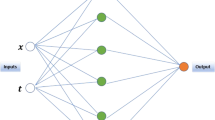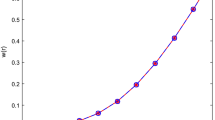Abstract
In this paper, a new method based on neural network is developed for obtaining the solution of the Navier–Stokes equations in an analytical function form. The solution procedure is based upon forming a trial solution consisting of two parts. The first part directly satisfies the boundary conditions and therefore, contains no adjustable parameters. The second part is constructed such that the governing equation is satisfied inside the solution domain, while the boundary conditions remain untouched. This part involves a feed-forward neural network, containing adjustable parameters (the weights), which must be determined such that the resulting approximate error function is minimized. The details of the method are discussed, and the capabilities of the method are illustrated by solving Navier–Stokes problem with different boundary conditions. The performance of the method and the accuracy of the results are evaluated by comparing with the available numerical and analytical solutions.









Similar content being viewed by others

Explore related subjects
Discover the latest articles, news and stories from top researchers in related subjects.References
Christiano V, Smarandache F (2008) An exact mapping from Navier–Stokes equation to Schrodinger equation via Riccati equation. Prog Phys 1:38–39
Dongyang S, Jincheng R et al (2009) A new second order nonconforming mixed finite element scheme for the stationary Stokes and Navier–Stokes equations. Appl Math Comput 207:462–477
Effati S, pakdaman M (2010) Artificial neural network approach for solving fuzzy differential equations. Inf Sci 180:1434–1457
Erdogan ME, Imrak CE (2009) An analytical solution of the Navier–Stokes equation for flow over a moving plate bounded by two side walls. J Mech Eng 55(12):749–754
Hayati M, Karami B (2007) Feed forward neural network for solving partial differential equations. J Appl Sci 7(19):2812–2817
Horiuchi K, Dutta P et al (2007) Electro osmosis with step changes in zeta potential in microchannels. AIChE J 53(10):2521–2533
Largris IE, Likas A et al (1998) Artificial neural networks for solving ordinary and partial differential equations. IEEE Trans Neural Netw 9(5):987–1000
Mohyuddin M et al (2008) Exact solutions of time-dependent Navier–Stokes equations by hodograph–Legendre transformation method. Tamsui Oxf J Math Sci 24(3):257–268
Odibat Z, Momani S (2006) Analytical spherically symmetric solution for the time-fractional Navier–Stokes equation. Adv Theor Appl Math 1(2):97–107
Zhang J, Liu F et al (2006) Electro-osmotic flow and mixing in heterogeneous microchannels. Phys Rev E 73:056305–056312
Author information
Authors and Affiliations
Corresponding author
Rights and permissions
About this article
Cite this article
Baymani, M., Effati, S., Niazmand, H. et al. Artificial neural network method for solving the Navier–Stokes equations. Neural Comput & Applic 26, 765–773 (2015). https://doi.org/10.1007/s00521-014-1762-2
Received:
Accepted:
Published:
Issue Date:
DOI: https://doi.org/10.1007/s00521-014-1762-2



